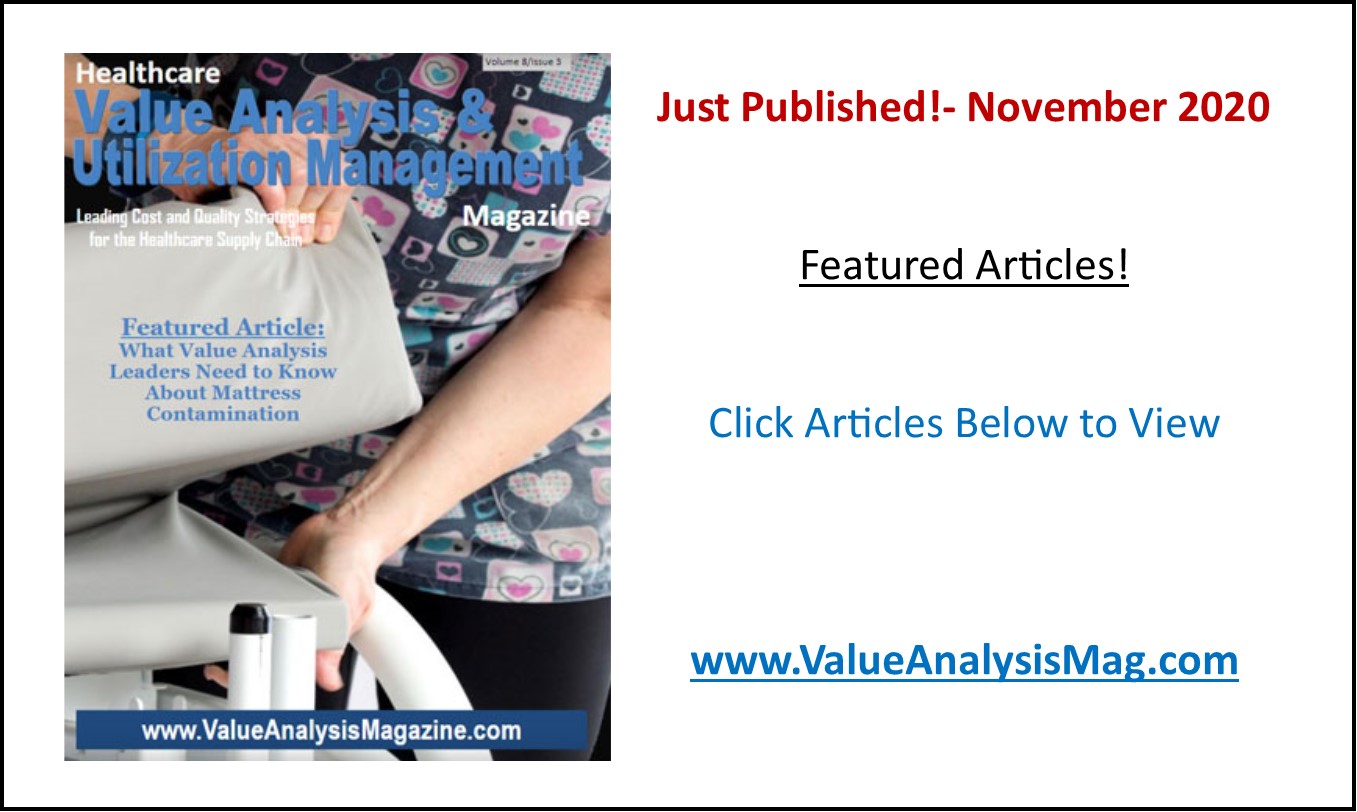Michael Bohon, Managing Director—Healthcare Solutions Bureau
How many times have you heard someone say the above statement as to why ideas, concepts and practices from other industries will not work in healthcare? Personally, I cannot count the times that I have.
I have worked in the supply chain world in three industries; steel, electronic and healthcare for 40+ years. The majority of that time was in healthcare. For the past 20 years I have also been involved with the development and presentation of supply chain educational material. These have been delivered in lecture, seminar, workshop and online formats, and about half of them have been through the auspices of the Institute for Supply Management (www.ism.ws).
This work has provided me the opportunity to observe, ask about and learn about the differences between the supply chains in different industries. The ISM programs are made up of participants that are from other than healthcare over 98% of the time, and those from healthcare are from the supplier side with only a couple of exceptions.
My purpose here is to compare some of the aspects of a supply chain operation between those in healthcare and those in a variety of other industries. My thoughts and comments are from my 30+ years of knowledge from my work in healthcare and from observations and discussions I have experienced during my interaction with supply chain professionals outside of healthcare.
I have selected a number of topics or areas of the supply chain activity. I will explain how they are dealt with outside of healthcare and how they compare to healthcare.
Recognition of Supply Chain’s (SC) Criticality
Naturally, this varies by industry and size of the organization. However, generally in non-healthcare industries the supply chain is recognized as a key part of the firm’s structure. They are represented in the leadership level usually in the C-suite. They are included in the decision-making process in most every aspect, especially those with a financial impact on the success of the company. It is not surprising to find that the mid and lower levels of the SC feel that their involvement should be increased, and their authority be strengthened.
The healthcare SC has made good progress in this area in the past 10–15 years. More and more examples are found of VP–Supply Chain and even CSO (Chief Supply Officers) throughout the country. However, there is much more progress to be made as there remains far too many cases of the Director level being the highest. This can only be corrected by SC professionals taking a proactive stance and proving to their leadership the benefits that can be derived from their knowledge and experience.
One significant remaining problem is healthcare’s lack of understanding of the importance of educational programs for those in the key support departments. People have heard my mantra that supply chain education is an investment, not an expense. Unfortunately, the leadership and those who control the purse strings fail to appreciate that fact.
Value Analysis
The concept of value analysis (VA) has been in healthcare for over 30 years. I worked at a hospital in 1986 that was one of the first to have an RN reporting to Materials Management. The progress was slow at first, but when the benefits of this approach began to become more obvious and meaningful, the interest began to grow. Now, when I talk to a hospital that is having difficulties controlling supply and inventory costs and contract compliance, I usually find that their VA system is either weak or in some cases non-existent.
When I ask my class participants from other industries if they utilize VA, they looked puzzled and shake their heads. When I change the question wording to value engineering (VE), the majority responds, “Of course!” VE is defined as a systematic method to improve the “value” of goods or products and services by using an examination of function. Value, as defined, is the ratio of function to cost. Value can therefore be manipulated by either improving the function or reducing the cost.
Sound familiar? VE was originated during World War II by General Electric (G.E). Because of the war, there were shortages of skilled labor, raw materials, and component parts. G.E. looked for acceptable substitutes. They noticed that these substitutions often reduced costs, improved the product, or both. What started out as an accident of necessity was turned into a systematic process. They called their technique “value analysis”. The name morphed into value engineering when it became mandated in federal agencies and programs.
VA in healthcare had a similar start when DRGs became a major force in reimbursement and hospitals had to improve the value ratio of the products they used in their operation to lower their costs and improve their outcomes. Its importance has been realized through the efforts of proponents such as Bob Yokl and others.
Contracts and Contract Management
There is another area where healthcare has made major improvements in the last 20 years and that is in the realm of contracts and contract management.
When I used to tell my classes that healthcare generally allowed suppliers to write the contracts, they stared at me in disbelief. Very few of them would ever consider allowing that to happen. Then, I explained that it was as a result of upper management’s lack of understanding of the value of good contract management in the supply chain and, therefore, they often would not provide the department resources in staffing and educational opportunities. Then they would shake their heads in dismay.
There has been a significant change for the better in healthcare. This is in part due to hospital systems doing more direct contracting with the suppliers and, to a degree, less dependence on group purchasing organizations (GPOs). Also, there has been a realization of the negatives that occur when the selling side controls the writing on the paper. This is another case of those SC departments with limited staff not having the tools available to optimize their contracts.
Contracts’ legal terms and conditions are an essential part of all contracts. Healthcare has made substantial advancements in their methods of addressing them. Other industries are heavily focused on addressing them in advance to ensure their legal and organizational goals and objectives are met. They work with the legal counsel to ensure that all critical issues are addressed in a manner that deals with the suppliers’ concerns while protecting themselves should any problem develop during the documents’ lives. If this is your methodology in the healthcare environment, you are to be commended. If not, perhaps you need to confront this situation.
While those outside of healthcare are shocked by the power that surgeons and physicians have in the contracting process, they often face a similar burden of working with engineers and R&D departments. The primary difference I have noted there is the willingness of their senior management to get involved and listen to the SC’s side before a final decision is reached.
In the area of negotiation other industries’ SC people are more schooled and trained to carry out this key function. They are also more empowered to represent their organization. They are just as frustrated as healthcare SC professionals with internal negotiations. In fact, over the past 20 years when asked, 100% of them respond to my question and say that internal negotiations are consistently more difficult than the external ones. Like healthcare, they use a team approach on a regular basis with the internal departments, but limit the participants when facing the suppliers’ representatives.
There are four areas where healthcare and other industries are vastly different. These are:
- Group Purchasing Organizations (GPOs) – Outside of healthcare they are referred to as buying consortiums and are very (!) limited in number across all industries. While their people seem intrigued by the concept, they remain wary of it as they express concern about losing some of their management’s control with contracts and supplier selection.
- Benchmarking Services – Such tools are virtually unheard of outside healthcare. When I mention them in my classes they display an interest in the details. When I provide more information, they express envy that such means are available elsewhere and wish they had access to something like them. They do, in some cases, benchmark pricing within their own company and its multiple sites, but have little or no access to the blind pricing from others in their industry. They also question the breadth, depth, and accuracy of the information.
- Multi-site Operations – Yes, healthcare is gradually morphing into more hospital systems that have sites in many areas across the country; Ascension Health, for example. Again though, the examples of this type are a relatively small number when you consider all the 5,500 hospitals around the country. On the other hand, it is common for many other industries to have sites not only across the US but also in multiple countries around the world. This can lead to significant issues both in number and complexity.
- International Operations – In the polls I take of my class participants, about 70% acknowledge that they are involved in international business dealings, either with suppliers or within their own company. In healthcare, there are a few of the largest systems that have an international presence, but they are a small minority. International commerce adds a whole new and complex layer of required knowledge and skills necessary for successful conduct of business. It is so relatively common in many industries that the Institute for Supply Management includes questions on international business issues in its exam for certification as a Certified Professional in Supply Management (CPSM).
Many of the readers of this missive will quickly say that what was stated here does not apply to their or their company’s situation. That may well be true. Remember, the statements here are simply a summary compilation of years of my observations and information collected in a relatively unscientific manner. It is a taste of comparisons and by no means all-inclusive. Should any readers wish to provide their comments or ideas, please contact me via email at bohon@hcsbureau.com. I will be glad to respond. www.hcsbureau.com





